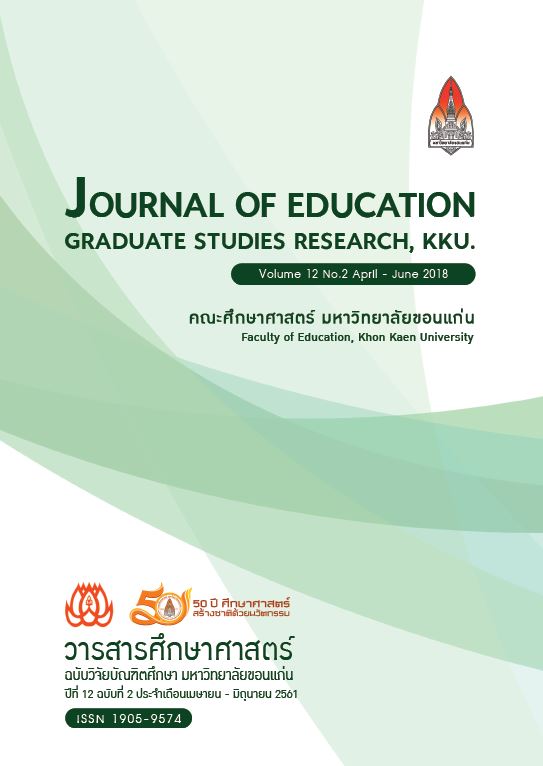The Development of English Writing Ability of Grade 9 Students Using CIPPA Model with PWIM
Main Article Content
Abstract
The purposes of this study were to develop English writing ability of grade 9 students using CIPPA model with PWIM with the condition that an average score of all students should be at least
70 percent of the total scores and at least 70 of the total numbers of the students must reach the prescribed criterion and to investigate the students’ satisfaction towards instruction using CIPPA model with PWIM. The target group comprised 20 grade 9 studentsat Wat Suthapotch School, Ladkrabang District, Bangkok Metropolitan Administration. The collected data were analyzed by calculating for percentage, mean and standard deviation The findings were as follows. The finding of the students’ English writing ability showed that an average score of all students was 31.80 or 79.50 percent of the total scores and 15 students or 75 percent of the total numbers of the students reached the prescribed criterion. The finding of the students’ satisfaction towards instruction using CIPPA model with PWIM
revealed that an average satisfaction score was at the high level. When considering each aspect of
satisfaction, content was the most highly satisfied. The average scores of satisfaction of learning and
teaching activities and teacher aspects.
Article Details
References
กระทรวงศึกษาธิการ. (2551). ตัวชี้วัดและสาระการเรียนรู้แกนกลางกลุ่มสาระการเรียนรู้ภาษาต่างประเทศตามหลักสูตรแกนกลางการศึกษาขั้นพื้นฐานพุทธศักราช 2551. กรุงเทพฯ: ชุมนุมสหกรณ์การเกษตรแห่งประเทศไทย.
________ . (2557). แนะนำ อาเซียน curriculumsourcebook. กรุงเทพฯ: สำนักงานพุทธศาสนาแห่งชาติ.
________. (2553). หลักสูตรแกนกลางการศึกษาขั้นพื้นฐานพุทธศักราช 2551. กรุงเทพฯ: ชุมนุมสหกรณ์การเกษตรแห่งประเทศไทย.
คำซาย จันทะหงส์. (2556). การพัฒนาผลสัมฤทธิ์ทางการเรียนเรื่องการสนธิคำ ในภาษาลาวโดยใช้รูปแบบการจัดการเรียนรู้แบบซิปปา(CIPPA MODEL) ของนักศึกษาคณะศึกษาศาสตร์ มหาวิทยาลัยสุภานุวงศ์
สาธารณรัฐประชาธิปไตยประชาชนลาว.วิทยานิพนธ์ปริญญาศึกษาศาสตรมหาบัณฑิตสาขาวิชาหลักสูตรและการสอนบัณฑิตวิทยาลัย มหาวิทยาลัยขอนแก่น.
นพเก้า ณ พัทลุง. (2538). การวิจัยในชั้นเรียน: หลักการและแนวคิดสู่ปฏิบัติ. สงขลา: ภาควิชาหลักสูตรและการสอน คณะศึกษาศาสตร์ มหาวิทยาลัยทักษิณ.
นิตยา ศรีดารา. (2557). การพัฒนากิจกรรมการเรียนรู้คณิตศาสตร์โดยใช้รูปแบบซิปปา (CIPPA Model) ที่เน้นกระบวนการแก้ปัญหาของโพลยาเรื่อง อสมการ ชั้นมัธยมศึกษาปีที่ 3. วิทยานิพนธ์ปริญญาศึกษาศาสตรมหาบัณฑิต
สาขาวิชาหลักสูตรและการสอน บัณฑิตวิทยาลัย มหาวิทยาลัยขอนแก่น.
ศิริวรรณ ร่มเย็น วูลเทอร์. (2555). การจัดกิจกรรมเพื่อเสริมทักษะการเขียน ภาษาอังกฤษ สำหรับนักเรียน ชั้นประถมศึกษาปีที่ 6 โรงเรียนสาธิตมหาวิทยาลัยขอนแก่น ฝ่ายประถมศึกษา (ศึกษาศาสตร์). ขอนแก่น: ฝ่ายประถมศึกษา โรงเรียนสาธิตมหาวิทยาลัยขอนแก่น (ศึกษาศาสตร์) มหาวิทยาลัยขอนแก่น.
Emily, C. (2001). Teaching Beginning Reading and Writing with the Picture Word Inductive Model. USA: Alexandria.
Xiaobin L. (2011). The Picture Word Inductive Model and English Vocabulary Acquisition– A Study in a Swedish Primary School. Retrieved Apr 1, 2016, from http://www.divaportal.org/smash/record.jsf?pid=diva2%3A430285&dswid=4420#sthash.CbtLLaWC.dpbs

